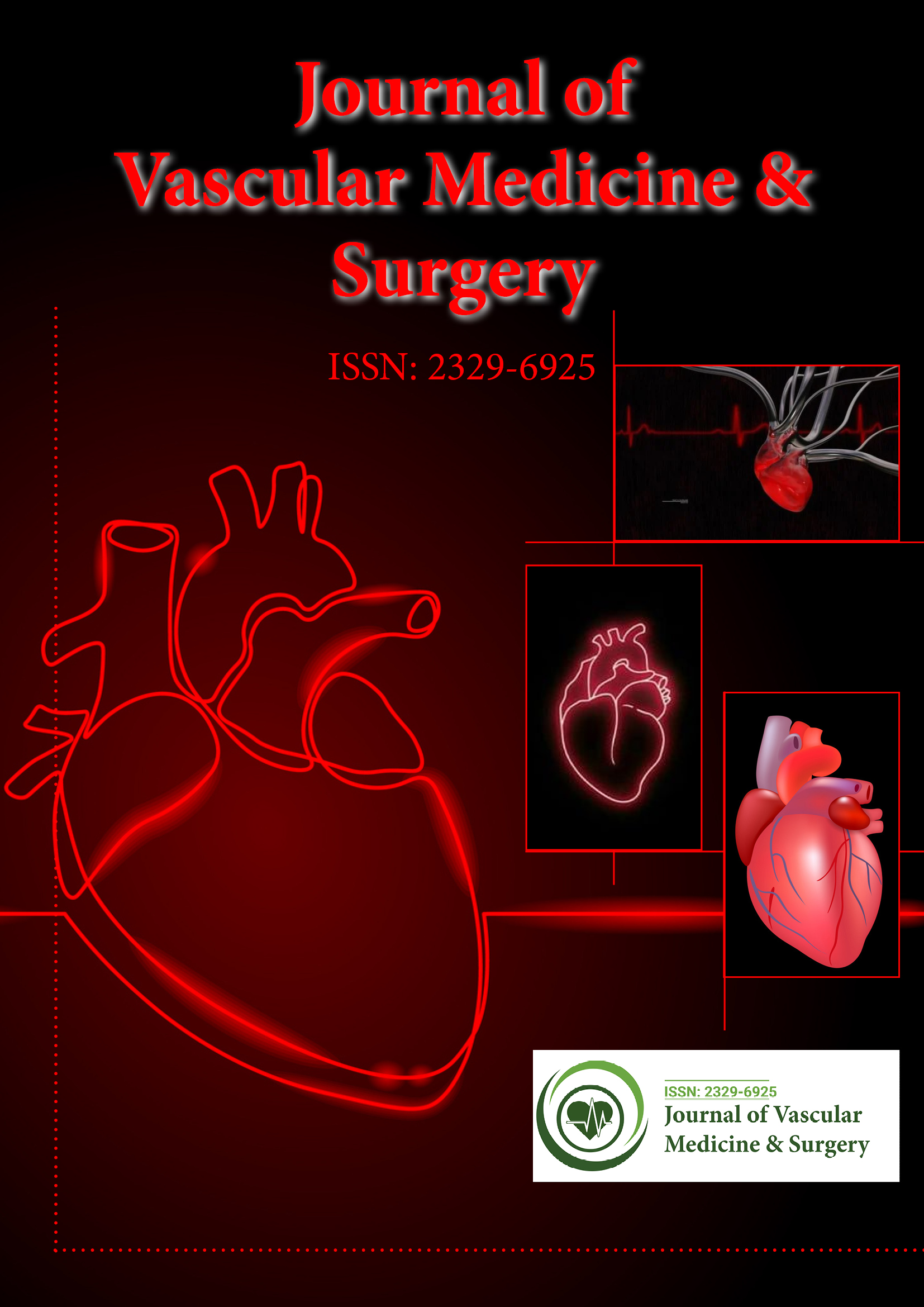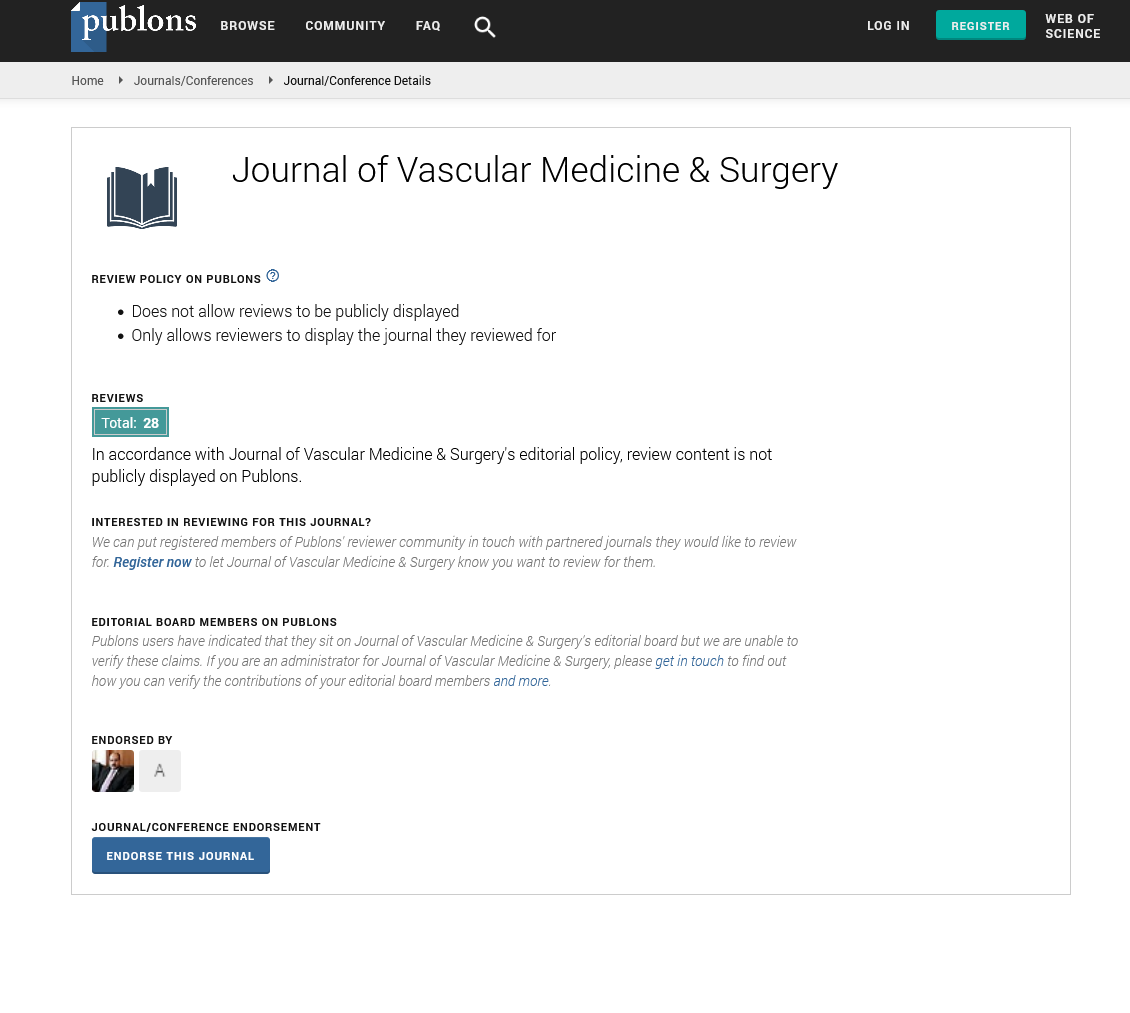Indexed In
- Open J Gate
- Academic Keys
- RefSeek
- Hamdard University
- EBSCO A-Z
- OCLC- WorldCat
- Publons
- Euro Pub
- Google Scholar
- SHERPA ROMEO
Useful Links
Share This Page
Journal Flyer

Open Access Journals
- Agri and Aquaculture
- Biochemistry
- Bioinformatics & Systems Biology
- Business & Management
- Chemistry
- Clinical Sciences
- Engineering
- Food & Nutrition
- General Science
- Genetics & Molecular Biology
- Immunology & Microbiology
- Medical Sciences
- Neuroscience & Psychology
- Nursing & Health Care
- Pharmaceutical Sciences
Perspective - (2025) Volume 13, Issue 8
Evolving Strategies to Manage Vascular Health Worldwide
Rupert Toby*Received: 22-Jul-2025, Manuscript No. JVMS-25-29909; Editor assigned: 24-Jul-2025, Pre QC No. JVMS-25-29909 (PQ); Reviewed: 07-Aug-2025, QC No. JVMS-25-29909; Revised: 14-Aug-2024, Manuscript No. JVMS-25-29909 (R); Published: 21-Aug-2025, DOI: 10.35248/2329-6925.25.13.612
Description
Vascular health is an essential pillar of overall human wellbeing, as the vascular system plays a critical role in delivering oxygen and nutrients throughout the body. Yet, around the world, vascular diseases are becoming increasingly common and continue to place enormous strain on healthcare systems. From heart attacks and strokes to peripheral artery disease and aneurysms, the burden of vascular conditions is growing across all continents, regardless of economic development.
The global burden of vascular disease
Vascular disease especially concerning is its often silent progression. Many individuals do not experience symptoms until the condition has reached an advanced or even life-threatening stage. As a result, early detection and intervention remain challenging. In developing nations, this is compounded by a lack of access to screening programs and specialist care, while in wealthier countries, lifestyle-related risk factors such as sedentary behavior, poor diet, and rising obesity levels continue to fuel vascular health issues.
Another major concern is the rising incidence of comorbidities. Conditions like diabetes, hypertension, and high cholesterol are tightly linked to vascular disease, and managing them requires coordinated care across specialties. Unfortunately, healthcare systems are often fragmented, especially in resource-limited settings, and many patients slip through the cracks due to inconsistent follow-up, limited resources, or a lack of health education.
Social and economic factors also play a crucial role. In many low-income regions, people are more likely to experience vascular complications due to poor nutrition, lack of health infrastructure, and limited access to medications. Meanwhile, urbanization and the increasing adoption of westernized diets are causing vascular diseases to appear earlier in life and affect a broader segment of the population. In contrast, more affluent countries are dealing with aging populations where vascular disease is already highly prevalent and often complicated by multiple chronic conditions.
Managing vascular health on a global scale requires an understanding of these diverse and evolving challenges. It calls for innovative thinking and adaptable strategies that are sensitive to local contexts. The same approach cannot work everywhere; solutions must be tailored to each region’s unique circumstances. However, there are common threads in the strategies being implemented across the world emphasizing prevention, improving diagnostics, optimizing treatment, and integrating technology to support better care.
Innovative and adaptive solutions across borders
As the understanding of vascular disease improves, so too does the range of strategies to combat it. Worldwide, governments, healthcare providers, and innovators are taking steps to evolve the way vascular health is managed—turning reactive systems into proactive ones.
One of the most important shifts in recent years has been the emphasis on prevention. Rather than focusing solely on treating advanced disease, many healthcare systems are now investing in preventive care models. Public health campaigns that encourage smoking cessation, healthy diets, regular physical activity, and blood pressure monitoring are having a measurable impact in some regions. Schools, workplaces, and communities are being engaged in health promotion efforts to encourage earlier lifestyle changes. In places where primary care systems are strong, routine screenings for vascular risk factors are being used to identify at-risk individuals before serious disease develops.
Alongside prevention, there has been significant progress in early diagnosis and monitoring. The use of portable diagnostic devices, such as handheld Doppler ultrasound units, is expanding the reach of vascular assessments to rural and underserved areas. These tools are allowing health workers to detect circulation issues earlier, even in places where specialist care is not immediately available. Mobile health units and telemedicine platforms are also helping to overcome geographic barriers, bringing expert consultations and follow-up care to patients who previously had no access.
On the treatment front, minimally invasive techniques have revolutionized vascular care. Endovascular procedures, which involve repairing blood vessels from within using catheters, stents, and grafts, are now widely adopted and increasingly available even in lower-resource environments. These approaches reduce hospital stays, lower risks, and enable quicker recovery compared to open surgeries. As training and equipment become more accessible, more countries are integrating these procedures into their healthcare systems.
Technology is playing a transformative role in almost every aspect of vascular care. Artificial intelligence is being used to analyze imaging results and identify vascular abnormalities with high precision. Predictive analytics are helping clinicians anticipate which patients are at greatest risk of events such as strokes or aneurysms. Meanwhile, wearable devices that monitor heart rate, blood pressure, and activity levels are empowering patients to take charge of their own vascular health and alert providers when early signs of trouble appear.
In addition to clinical and technological advances, many countries are recognizing the importance of health system integration. Coordinated care models that bring together primary care, vascular specialists, nurses, pharmacists, and allied health professionals are proving effective in managing complex vascular conditions. Multidisciplinary teams are able to address not only the medical issues but also the social and behavioral factors that influence outcomes. Community health workers are also being leveraged in several countries to bridge gaps in care and follow-up, particularly for chronic disease management.
Crucially, all of these evolving strategies depend on education and empowerment. Patients need to understand the importance of vascular health and how their lifestyle choices impact their risk. Health professionals require up-to-date training to keep pace with emerging treatments and tools. Policymakers need data-driven guidance to prioritize funding and implement effective public health interventions. Education at every level is the foundation for long-term improvements in vascular health outcomes.
Conclusion
The management of vascular health is no longer confined to hospitals and surgical suites it is evolving into a global effort involving prevention, early diagnosis, advanced treatment, and community engagement. From low-tech grassroots campaigns to high-tech medical interventions, countries around the world are finding diverse and creative ways to tackle the growing burden of vascular disease. While the strategies vary by context, the shared goal remains the same: to reduce suffering, improve outcomes, and empower individuals to live longer, healthier lives. As the challenges continue to evolve, so too must the solutions flexible, inclusive, and driven by innovation.
Citation: Toby R (2025). Bridging Research and Practice in Vascular Medicine. J Vasc Surg. 13:612
Copyright: © 2025 Toby R. This is an open-access article distributed under the terms of the Creative Commons Attribution License, which permits unrestricted use, distribution and reproduction in any medium, provided the original author and source are credited.

